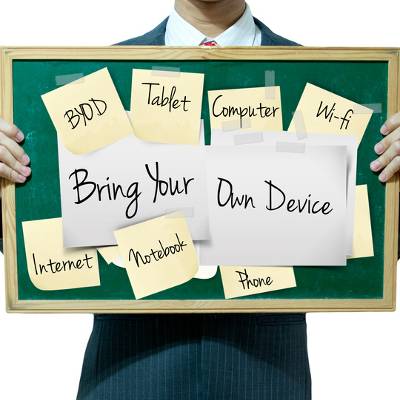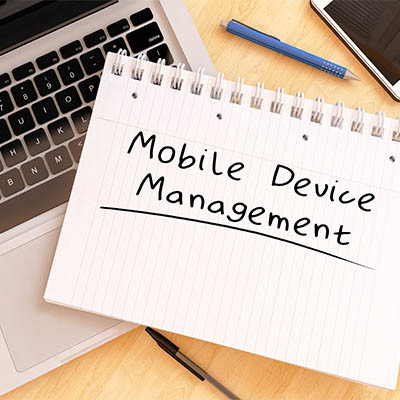The Connection, Inc Blog
Productivity. Your company needs it. Your employees are measured largely by their ability to effectively turn their effort into a tangible product or service that creates revenue. It really means everything to your business. Why then, if it is so necessary, is it so hard to get the people you depend on to realize just how important their productivity is to the success of the business? Let’s discuss what makes a business productive, and what technology will mitigate the major barriers to productivity.
Network security can be tough; there’s a lot to know, and you often need to have trained professionals on your side to ensure your systems are as secure as possible. With the right solutions on your side, however, it can be made much more manageable. Let’s discuss some of the most important security features your organization should implement and why.
For a lot of businesses, employee mobile phone usage was once a big problem for them. There have been some businesses that actually hired someone to walk around their office telling people to get off their phones. Some businesses outlawed employee devices altogether. There probably are some businesses out there that still limit the use of these devices in their office, but for most businesses, their employees’ smartphones are now completely part of their productivity strategy. Let’s take a quick look at the shift from banned to benefit in this month’s newsletter.
Make no mistake, the impact that your mobile device strategy has on your business is an important one. It can make or break your organization’s security, as well as stymie or encourage your organization’s productivity. Therefore, you should do everything in your power to make sure that your mobile device management platform is working to your company’s advantage. Let’s take a look at some of the features that all good MDM platforms should enable.
As you might expect, the remote circumstances that many business professionals have found themselves in as of late have created challenges that must be overcome, especially in regards to the access and dissemination of data to mobile devices. Let’s examine the mobile device’s role in the modern business and how you can ensure these great tools are being used properly for your organization.
It’s no surprise that mobile technology has infiltrated the workplace in more ways than one. Many businesses issue company-owned devices to their employees to get work done while out of the office, while others allow employees to bring their own devices, or use their own laptops and smartphones for fulfilling their day-to-day duties. That being said, it’s important to remember that mobile devices need to be managed in a very specific way to maintain security.
While smartphones and tablets can help businesses quite a bit, they can also be quite detrimental to their success. If you can get past the issues related to employees bringing their own devices to the workplace, then you’ll be able to save a considerable amount of time and resources on device procurement, but you certainly want to make sure you have a mobile device management policy put in place first.
Mobile Device Management in a Nutshell
Mobile Device Management, or MDM, allows your employees to use their mobile devices for work purposes, but without the many risks associated with doing so. It does this by using encryption, giving an administrator control over who accesses what information based on pre-established roles and permissions. This basically gives your employees the freedom to use their devices for work purposes, minus the frustration that it causes for you. This keeps your data as secure as possible while maintaining employee freedoms. Businesses that have a Bring Your Own Device (BYOD) policy generally take advantage of MDM as part of it.
What MDM Allows
MDM allows for several benefits that are great for businesses looking to save money and keep their devices secure:
- Cost Effectiveness: The fewer devices you have to purchase for your employees, the more you’ll save in procurement. If you go the route of BYOD, an MDM can alleviate some of your concerns regarding this.
- Management Capabilities: MDM gives your business the ability to oversee the security of any employee device, even remotely. This can help to make sure that a device doesn’t bring a threat home to the network unknowingly. It also gives your administrators the ability to make sure work-related applications are installed and configured properly. Admins also have the power to block any distrust worthy apps or users, as well as remotely wipe any lost BYOD devices to keep them from being used to access company data.
- Improved Compliance: Some industries have specific standards that must be met in order to avoid repercussions or comeuppance. MDM solutions are all about maintaining compliance with these standards. This gives businesses an advantage if they ever encounter a data breach.
To learn more about how The Connection can help you with MDM, reach out to us at (732) 291-5938.
Smartphones, laptops, and Chromebooks empower today’s workforce to be more mobile, and employees are often the driving force behind this. Chances are, if your business hasn’t even begun to think about your mobile IT strategy, a percentage of your staff already has.
Last year, Gartner conducted a huge survey that concludes just that. Here are the stats:
- 8 in 10 of employees bring their personal mobile device to work.
- 37% of employees receive laptops from their employer.
- Only 23% of employees surveyed were given corporate-issued smartphones.
- Yet, 10% of employees given a work device don’t use personal devices as well.
- That said, only 20% of all employees who were given a work device were dissatisfied with it. Typically the satisfaction level is higher with smartphones compared to desktops and laptops.
- More than 50% of all employees who use smartphones for work use their personal device.
- 2/3 of employees use a personal device, whether it is a smartphone, tablet, or laptop, for work.
So what does all of this have to do with your data? Employers have worked hard to protect and centralize company information, and control access to files and email. Once employees add personal mobile devices to the mix, it adds a whole new layer of complexity.
So Really, What Are the Risks of Personal Devices?
If left unchecked, there are plenty of risks. This is why employers go to such drastic lengths to try and control mobile device use in the workplace; or, even prevent it altogether.
A lost smartphone or tablet could give someone access to company email, which might include sensitive client information, processes, passwords, and a whole lot of other data. A personal laptop that gets hacked or infected could bring the same risks, while spreading the infection onto your network. If an employee uses public Wi-Fi, even a novice could muscle their way into the data and get passwords, correspondence, and other information.
Even worse, if a disgruntled employee quits, they could have access to your contact lists, files, and everything else they had while employed. The trouble they can cause could keep you busy for a long time.
Let The Connection Help Devise your BYOD Strategy
A BYOD (Bring Your Own Device) strategy, also known as a mobile device management strategy, will protect your company’s data, as well as allow employees to take advantage of mobile devices and the many benefits they can bring to an organization. By crafting a thoughtful, well-documented plan for what’s allowed, what needs to be done, and what’s at stake, you can keep business moving quickly without hindering employees or your data. Plus, many of the key elements of a BYOD policy can drive even more innovation and collaboration.
Let’s talk about it. Give us a call at (732) 291-5938 and ask how we can protect your data while keeping your business mobile.
 For small and medium-sized businesses, technology management can be a tricky situation. You want to ensure that your IT doesn't break your budget, but you also want to make using your technology as easy as possible for your end users. Unfortunately, for many employees, your business’s technology conduct and practices could be driving them insane.
For small and medium-sized businesses, technology management can be a tricky situation. You want to ensure that your IT doesn't break your budget, but you also want to make using your technology as easy as possible for your end users. Unfortunately, for many employees, your business’s technology conduct and practices could be driving them insane.
 Mobile devices have taken the workplace environment by storm, and you’d be hard-pressed to find anyone who doesn’t use their smartphone, laptop, or other device for work purposes. This trend, called Bring Your Own Device (BYOD), helps employers spend less on new solutions, but it also presents a risk that needs to be managed: the Internet of Things (IoT).
Mobile devices have taken the workplace environment by storm, and you’d be hard-pressed to find anyone who doesn’t use their smartphone, laptop, or other device for work purposes. This trend, called Bring Your Own Device (BYOD), helps employers spend less on new solutions, but it also presents a risk that needs to be managed: the Internet of Things (IoT).
 Mobile devices are challenging the traditional perception of the office environment. When employees bring their own devices to work, this is called Bring Your Own Device (BYOD), and it’s an increasingly popular trend. Initially thought of as a threat, BYOD is proving to be a valuable option for businesses wanting to increase productivity, so long as it’s regulated properly.
Mobile devices are challenging the traditional perception of the office environment. When employees bring their own devices to work, this is called Bring Your Own Device (BYOD), and it’s an increasingly popular trend. Initially thought of as a threat, BYOD is proving to be a valuable option for businesses wanting to increase productivity, so long as it’s regulated properly.
 Mobile devices are changing the way that businesses look at the workforce, but one of the main draws (and possibly detriments) is how the industry continues to change rapidly as new solutions are made available. In order to maximize your business’s efficiency with mobile devices, it’s important to consider these three trends shaping the way that organizations handle modern mobile device management.
Mobile devices are changing the way that businesses look at the workforce, but one of the main draws (and possibly detriments) is how the industry continues to change rapidly as new solutions are made available. In order to maximize your business’s efficiency with mobile devices, it’s important to consider these three trends shaping the way that organizations handle modern mobile device management.
 As expected, mobile technology is a consistent part of daily business operations for many companies around the world. Employees love taking advantage of the mobility these devices offer, making their home office just as useful as their in-house workstation. However, a mobile device management solution needs to be strictly adhered to in order to optimize security and guarantee that a stray smartphone doesn’t expose your data to unexpected eyes.
As expected, mobile technology is a consistent part of daily business operations for many companies around the world. Employees love taking advantage of the mobility these devices offer, making their home office just as useful as their in-house workstation. However, a mobile device management solution needs to be strictly adhered to in order to optimize security and guarantee that a stray smartphone doesn’t expose your data to unexpected eyes.
 A trend that’s taking the office by storm is BYOD, or Bring Your Own Device. These policies entail workers bringing their own devices to the office and using them for work-related purposes. While this opens up many avenues for enhanced productivity and efficiency, being too laissez faire with your BYOD policy could instigate some problems later on, primarily in the security field.
A trend that’s taking the office by storm is BYOD, or Bring Your Own Device. These policies entail workers bringing their own devices to the office and using them for work-related purposes. While this opens up many avenues for enhanced productivity and efficiency, being too laissez faire with your BYOD policy could instigate some problems later on, primarily in the security field.
 As a technology consumer, you might realize that your mobile device’s hard drive storage space is somewhat lackluster compared to your needs. Countless photos, applications, and videos take up a ton of space, and if something were to cause the device to fill up suddenly, you’d be out of luck. How can you prevent this? You can start by using these four tips to get around your device’s lack of storage.
As a technology consumer, you might realize that your mobile device’s hard drive storage space is somewhat lackluster compared to your needs. Countless photos, applications, and videos take up a ton of space, and if something were to cause the device to fill up suddenly, you’d be out of luck. How can you prevent this? You can start by using these four tips to get around your device’s lack of storage.
 Employees bringing their own mobile devices into the workplace (BYOD) is one of the hottest business technology trends. BYOD has been shown to increase productivity, but when it’s implemented improperly, it can leave your business vulnerable to security threats. How do you motivate employees to stick to your BYOD policy in order to ensure the safety of your company’s data?
Employees bringing their own mobile devices into the workplace (BYOD) is one of the hottest business technology trends. BYOD has been shown to increase productivity, but when it’s implemented improperly, it can leave your business vulnerable to security threats. How do you motivate employees to stick to your BYOD policy in order to ensure the safety of your company’s data?
 As mobile technology booms, employers and employees are learning how to best take advantage of using new mobile technology in the workplace (a trend known as BYOD). To be sure, there are several advantages that come with BYOD, but there’s still hesitancy for many businesses to fully adopt mobile technology due to a lack of trust.
As mobile technology booms, employers and employees are learning how to best take advantage of using new mobile technology in the workplace (a trend known as BYOD). To be sure, there are several advantages that come with BYOD, but there’s still hesitancy for many businesses to fully adopt mobile technology due to a lack of trust.
 Mobile technology has invaded our very way of life. We don’t leave the house without our mobile phones, and many business owners have their phones integrated to connect with their company’s network. The average user has many different social media applications and others that utilize personal information. What would happen if you lost it?
Mobile technology has invaded our very way of life. We don’t leave the house without our mobile phones, and many business owners have their phones integrated to connect with their company’s network. The average user has many different social media applications and others that utilize personal information. What would happen if you lost it?
 The concept behind BYOD seems really good--employees bring their personal devices to work and use them to accomplish company projects. Initially, BYOD was well received, but after reviewing the security risks, more companies are opting out of it. Is there another way to use mobile devices at work without all the hassle and risks of BYOD?
The concept behind BYOD seems really good--employees bring their personal devices to work and use them to accomplish company projects. Initially, BYOD was well received, but after reviewing the security risks, more companies are opting out of it. Is there another way to use mobile devices at work without all the hassle and risks of BYOD?
News & Updates
Understanding IT
Get the Knowledge You Need to Make IT Decisions
Technology is constantly evolving, and keeping up can feel overwhelming. Whether you want to understand cybersecurity threats, explore automation, or learn how regulations like PCI DSS impact your business, we’ve made it easy to access clear, straightforward insights on key IT topics.
Contact Us
Learn more about what The Connection can do for your business.
The Connection
51 Village CT
Hazlet, New Jersey 07730








